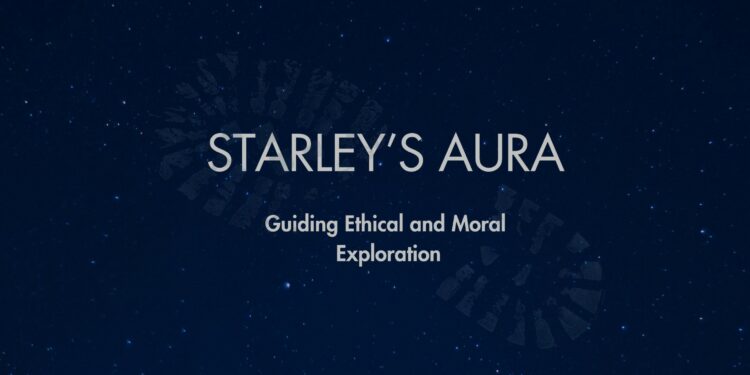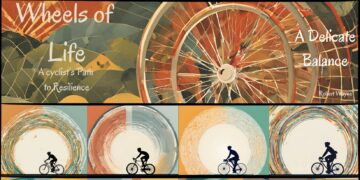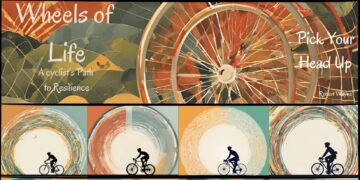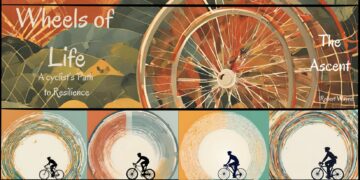Excerpt from the Short Story “Starley’s Aura: Guiding Ethical and Moral Exploration.”
Humanity’s Interstellar Impression
Amid the holographic constellations and the palpable atmosphere of curiosity, a profound shift begins to ripple through the classroom, mirroring the complexities of the universe itself. Dr. Starley Amano, renowned for her transformative guidance, leads her students on a journey that transcends mere learning. Her lectures are not just presentations, but portals that transport her students to the heart of ethical exploration, a terrain as strenuous as the farthest reaches of interstellar space.
The vibrant and dynamic discussions, reverberating within the hallowed walls of academia, serve as a backdrop to Starley’s contemplation. Engagements with colleagues and fellow thinkers, rich with diverse perspectives, punctuate her journey, carrying within them the weight of ethical considerations that have emerged alongside humanity’s cosmic endeavors. Scientific reports, filled with the adverse effects of explorers battling the physical effects of space travel, emerge as cautionary tales, spotlighting the scientific marvels and the profound ethical crossroads that underlie the pursuit of knowledge within exploration.
Once a stage for celestial narratives, the classroom has metamorphosed into a forum for probing questions where the intersection of scientific achievement and ethical reckoning becomes the focal point. Conversations about the physiological toll of microgravity and the silent dangers of radiation unveil a complex web of concerns that entwines the exhilaration of discovery with the somber recognition of sacrifices made.
As the holographic projections painted a vivid backdrop within Starley’s classroom, the philosophical dialogues unfolded among her students and peers echo the profound cosmic dilemmas woven into her thoughts. In this classroom, where the boundaries of space and ethics material, the audacious essence of exploration stood starkly juxtaposed with the weighty ethical responsibilities that invariably accompany it.
Starley was a seasoned explorer, having ventured far beyond the comfortable confines of Earth. She had felt the bone-chilling cold of deep space seeping through her spacesuit. She marveled at the brilliance of distant stars shimmering against the inky void. But with each of her missions came the relentless companions of physical and psychological challenges.
The challenges that space explorers endured exemplified humanity’s remarkable resilience and fever for exploration in the face of space’s harsh and unforgiving vacuum. Space, where temperatures could plummet to hundreds of degrees below freezing, was an ever-present threat to organic life. Explorers contended with the relentless radiation from distant stars and the fragile isolation of their spacecraft, which became both sanctuary and prison during their journeys.
Microgravity, without weight, presented one of the most formidable adversaries. The human body, accustomed to the steady pull of Earth’s gravity, underwent profound changes in this alien environment. Muscles atrophied, bones weakened, and the circulatory system adapted strangely. It was a physical battle, where even the simplest tasks required careful planning and meticulous execution.
Yet, the most formidable challenges often lie within the minds of these intrepid explorers. The loneliness, the overwhelming silence of space, and the claustrophobic environment of a spacecraft could be devastating to one’s mental health. The infinite darkness beyond the spacecraft’s window could be mesmerizing and terrifying.
Psychological stressors such as spacecraft fever, isolation, and the ever-present awareness of the vast, indifferent cosmos could gnaw at the mental fortitude of even the most seasoned explorer. Loneliness, homesickness, and the sense of being marooned in the ultimate solitude of space were emotions that they struggled with daily.
In Starley’s classroom, these challenges served as metaphors for humanity’s broader struggle. The audacious ambition to explore and conquer the cosmos starkly contrasted with the weight of ethical introspection. It was a juxtaposition that Starley had wrestled with during her space missions.
Space exploration was proof of human ingenuity and curiosity but also raised profound ethical questions. How far should humans venture into the cosmos? What responsibility did they bear to the celestial bodies they encountered and the lifeforms that might dwell there? These questions formed the heart of the cosmic dilemmas Starley sought to convey to her students.
Ultimately, the classroom was not just a place of learning but a crucible where minds contemplated the essence of human ambition, the delicate balance of ethics, and the profound physical and psychological challenges that space explorers faced as they sought to touch the stars. With her unique perspective as both an explorer and a professor, Starley guided her students through this intellectual odyssey, urging them to contemplate the mysteries of the cosmos and the responsibilities that came with the journey.
Amid the holographic constellations and the dialogues echoing in the halls from within Starley’s classroom, a profound moral and ethical dilemma loomed in this cosmic theater. Space exploration, with its awe-inspiring wonder and audacious ambition, beckoned humanity to push the boundaries of the known. Yet, as students and professors struggled with the challenges faced by explorers, both physical and psychological, a more profound question emerged: To what end?
Was it the insatiable human curiosity that drove us into the far reaches of our solar system, seeking to decipher its mysteries and unravel the secrets of the universe? Or was it the yearning for conquest, to stake our claim in our solar system and declare our presence in the cosmos? These queries floated among the holographic stars like constellations of ethical introspection.
The ethical dilemma of sending humans into space was not merely an academic exercise but the core of humanity’s cosmic journey. It challenged us to contemplate the how of exploration and the why, which is at the heart of our audacious ventures. Was it a quest for knowledge, a yearning for connection, or the indomitable spirit of discovery that spurred us onward?
Her gaze fixed upon the holographic cosmos, Starley knew the answers to these questions held the key to humanity’s future among the stars. As she guided her students through the cosmic dilemmas and ethical intricacies, she imparted not only the desire to explore but also the wisdom to question, navigate the moral maze, and recognize that the pursuit of knowledge was inexorably linked to the profound responsibilities that came with it.
Ultimately, the classroom became a vessel of contemplation, where minds struggled with the challenges of exploration and the purpose that illuminated humanity’s cosmic journey. This purpose remained as vast and enigmatic as the universe itself.
Within the classroom, the holographic display shifts to show an image of an alien landscape, a world untamed and exotic in every sense of the word. The students lean forward in rapt attention, their curiosity illuminated by the projections but also tempered by the realization that this realm might house lifeforms dangerous to humanity.
Starley’s voice, measured and contemplative, guides the debate. “Imagine this scenario,” she begins, her gaze intent on the enigmatic landscape. “Explorers from Earth venture to this distant planet, a realm where life may have evolved along paths we cannot comprehend. The allure of unraveling its mysteries is undeniable. Yet, the emerging ethical quandaries are as profound as the physical challenge to get there. Do we approach with humility, recognizing our intrusion and the potential dangers we bring? How do we engage with lifeforms that may perceive us as threats or react violently to our presence?”
The room comes alive with a chorus of thoughts and perspectives. Students exchange glances with witty dialogue, each recognizing the ethical tightrope accompanying this cosmic expedition. The holographic stars, once simple points of light, now embody the complexities of human aspiration. They twinkle with the recognition that the cosmic journey, while filled with grandeur, is also fraught with ethical intricacies and the weight of our choices and actions.


















